Processor Design¶
约 2919 个字 62 张图片 预计阅读时间 10 分钟
Introduction¶
- CPU performance factors
- 指令数量:由 ISA 和编译器决定
- CPI and Cycle Time: Determined by CPU hardware
Instruction Execution Overview¶
- For every instruction, the first two step are identical
- Fetch the instruction from the memory
- Decode and read the registers
- Next steps depend on the instruction class
- Memory reference
- Arithmetic logical
- branches
- Depending on instruction class
- Use ALU to calculate: arithmetic result, memory address for load/store, branch comparison
- Access data memory for load/store
- PC <- target address or PC + 4

回顾在计逻中介绍的,我们不能直接将两根线连在一起,这时候我们就需要多路选择器来控制 CPU 的传输,综合起来就是一个控制单元。

Building a Datapath¶
- Datapath: Elements that process data and adresses in the CPU.
Instruction execution in RISC-V¶

Instruction Fetch¶

在不考虑跳转的时候,由于 PC 没有控制信号,每个时钟周期都加 4。
R-Format Instructions

寄存器的模块中,读取没有控制信号,写有控制信号。对于 R-Format 的指令,我们将从寄存器中读取的数据经过 ALU 计算,将结果写入 Register。
Load/Store Instructions

上图右侧的立即数扩展单元,由于 Load/Store 需要用 ALU 进行地址计算,但 ALU 是 64 位的,因此我们需要将 12 位的立即数扩展成 64 位。
Branch Instructions


其中左移一位的原因是:注意到我们 PC 相对寻址,是将 PC 指针加上立即数乘以 2 (指令中存储的立即数是没有第 0 位的)。
Composing the Elements
由于我们整个过程都需要在一个时钟周期内完成,而 datapath 中的每一元件只能一次计算一个 function,因此我们将指令内存和数据内存分开。
Path Built using Multiplexer¶
R type Instruction & Data Stream¶
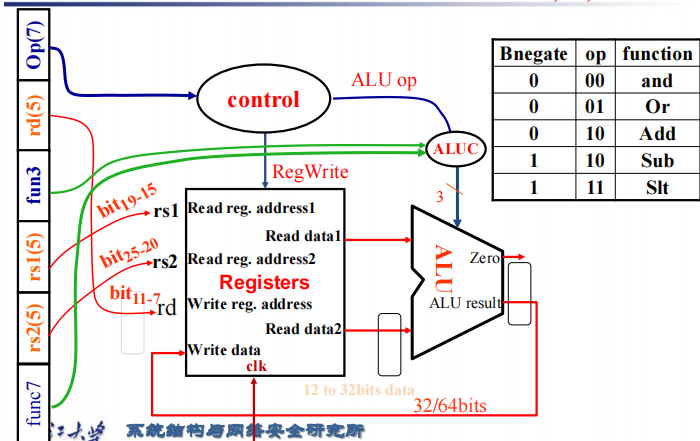
首先根据指令读取两个源寄存器和一个目的寄存器,经过寄存器单元得到源寄存器的数据,送到 ALU 计算单元。根据指令中的 opcode 决定进行 ALU 运算, 根据 fun3 和 fun7 决定进行哪种 ALU 运算,最后 ALU 运算结果写入目的寄存器中。
I type Instruction & Data Stream¶
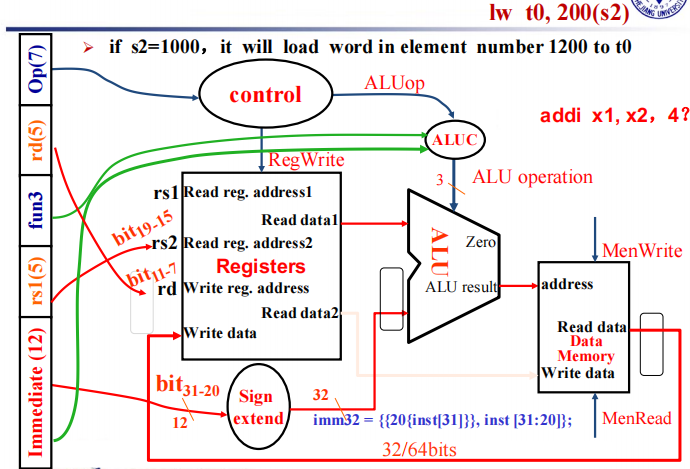
首先根据指令读取两个寄存器,经过寄存器单元得到源寄存器的数据。根据指令读取立即数,并经过立即数扩展单元将 12 位立即数扩展成 32 位,与寄存器中的数据经过 ALU 运算得到内存地址,送入 Memory 中得到数据,最后写入目的寄存器中。
S type Instruction & Data Stream¶
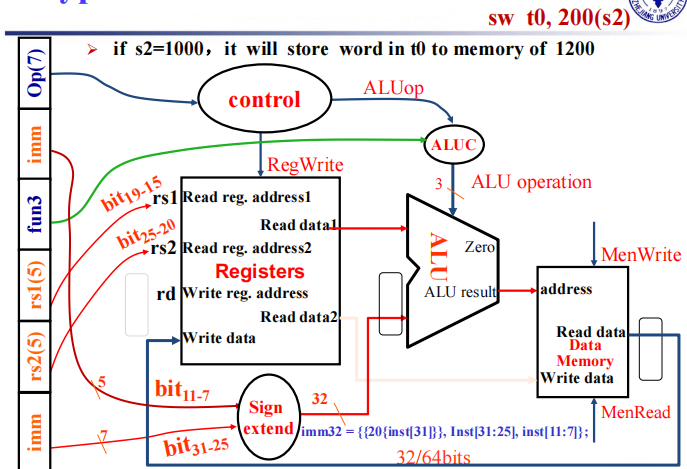
需要注意的是 sw 指令是没有最下面写进寄存器的数据通路的。
SB type Instruction & Data Stream¶
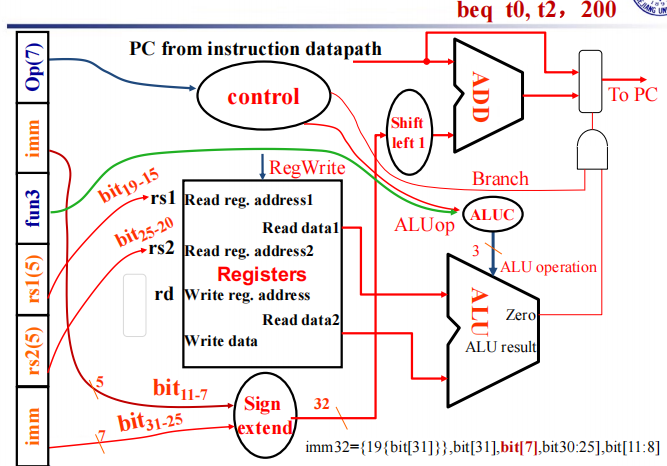
首先将指令中两个寄存器的值取出来,经过寄存器单元得到相应数据,通过 ALU 进行比较。其次将指令中的立即数取出,通过立即数扩展单元并左移一位后与 PC 相加,最后根据 ALU 的计算结果判断是否跳转。
Jal type Instruction & Data Stream¶

需要注意的是上图没有将 PC + 4 的值存在寄存器中。
R-Type/Load/Store Datapath

Full Datapath
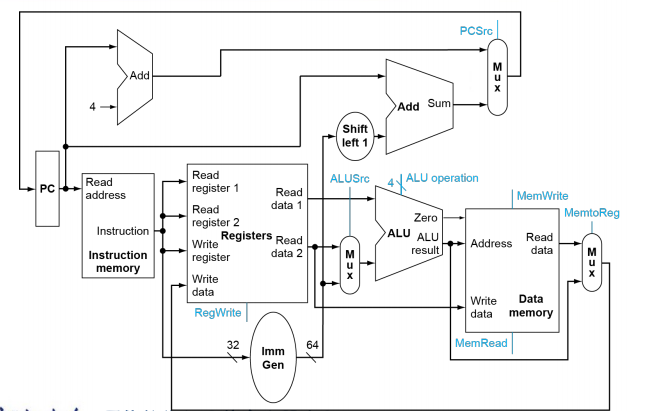
现在我们需要决定选择信号的值,这时候就需要控制单元。
A simple Implementation Scheme¶
Analyse for cause and effect
- Information comes from the 32 bits of instruction
- Selecting the operations to perform(ALU, read/write, etc.)
- Controlling the flow of data(multiplexor inputs)
- ALU's operation based on instruction type and function code.



ALU Control¶
ALU used for:
- Load/Store: F = add
- Branch: F = subtract
- R-type: F depends on opcode
Scheme of Controller
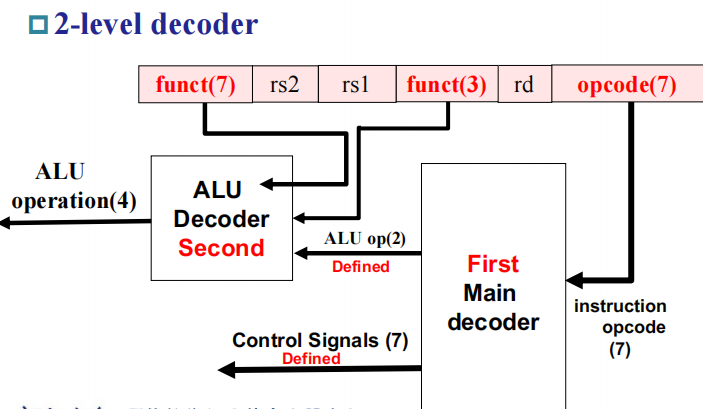
知道 opcode 之后大部分控制信号都已经定下来了, 仅对于 R-type 指令我们需要根据 function code 进一步判断进行哪种操作,因此我们对控制信号做两级解码。
Designing the Main Control Unit(First Level)¶
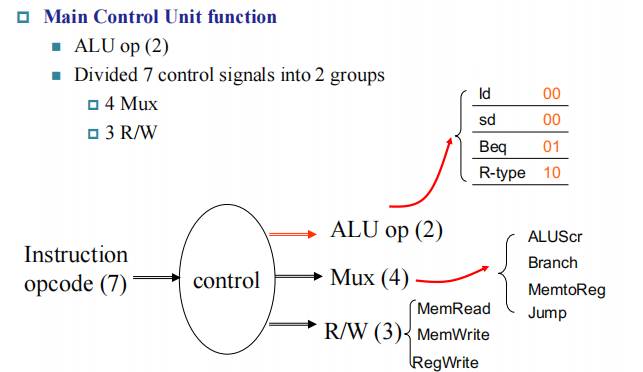
我们先进行第一层解码,通过指令的 opcode 将控制信号分为三大类:ALU operation, Mux, R/W。进一步我们将 ALU op 解码成 2 位,如上图所示。
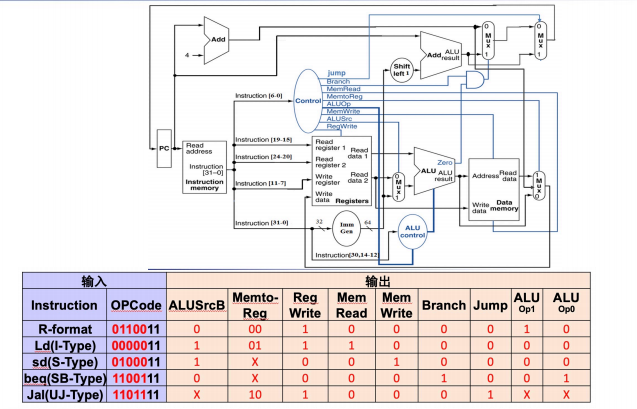
因此我们可以根据 opcode 得到所谓的真值表。
Design the ALU Decoder(Second Level)¶
ALU operation is decied by 2-bit ALUOp derived from opcode, and funct7 & funct3 fields of the instruction.

Datapath with Control

Pipelining¶
首先我们假设 Memory 访问需要 200ps, ALU 和加法器需要 200ps, 访问 register file 需要 100ps, 则对于单周期 CPU 各种操作的时间如下表所示:

我们可以发现每一种指令执行的时间实际上是不一样的。因此对于单周期 CPU,我们只能选取最长的时间作为时钟频率。考虑实际应用中,ld 指令其实相对比较少(总不可能一直在访问 Memory ), 因此降低了 CPU 的性能。
总结如下:
- Longest delay determines clock period
- Critical path: load instruction
- Not feasible to vary period for different instructions
- Violates design principle: making the common case fast
因此我们引入流水线的概念来提升性能。

RISC-V Pipeline¶
Five stages, one step per stage
- IF: Instruction fetch from memory
- ID: Instruction decode & register read
- EX: Execute operation or calculate address
- MEM: Access memory operand
- WB: Write result back to register
7
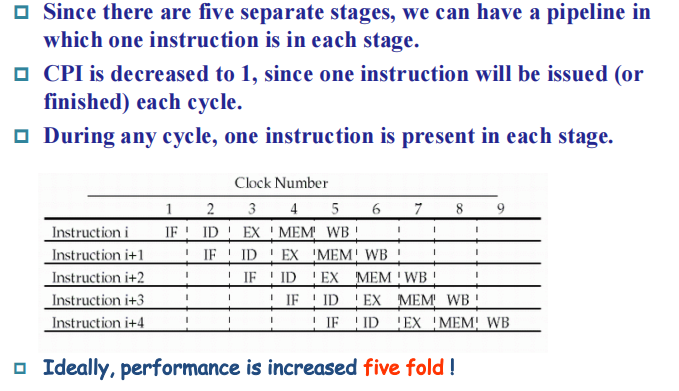
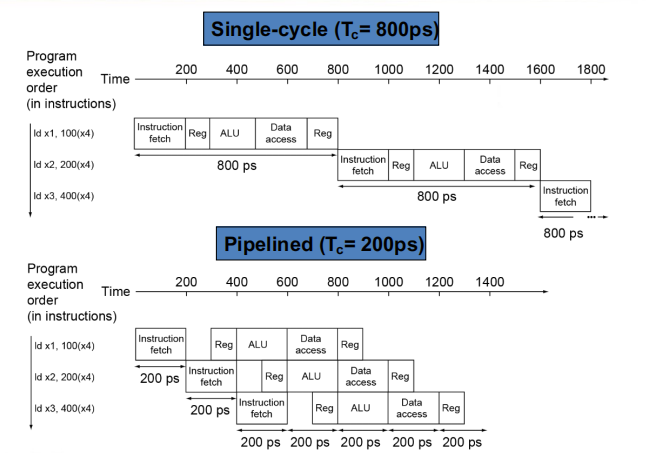
Pipeline Speedup¶
- If all stages are balanced(all take the same time):
- Time between instructions = Nonpipelined / Number of stages
- If not balanced, speedup is less
- Speedup due to increased throughput, latency(time for each instruction) does not decrease
Pipelining and ISA Design¶
RISC-V ISA designed for pipelining
RISC-V 的架构很适合流水线加速:
- All instructions are 32 bits, easier to fetch and decode in one cycle.
- Few and regular instruction formats
- can decode and read registers in one step.
- Load/store address
- can calculate address in 3rd stage, access memory in 4th stage.
但是流水线也存在问题:试想一种情况,一条指令需要用到上一条指令存到寄存器的数据作为操作数,但是上一条指令 WB 在第五个时钟周期完成,而该指令在第二个周期就要执行,造成错误。
Hazards¶
- Situations that prevent starting the next instruction in the next cycle.
- Structure hazards
- A required resource is busy(一条指令处在 ID,另一条指令处在 WB,有可能出现结构竞争)
- Data hazard
- Need to wait for previous instruction to complete its data read/write
- Control hazard
- Deciding on control action depends on previous instruction
Structure Hazards¶
In RISC-V pipeline with a single memory
- Load/Store requires data access
- Instruction fetch would have to stall for that cycle
- Would cause a pipeline "bubble"
Data Hazards¶
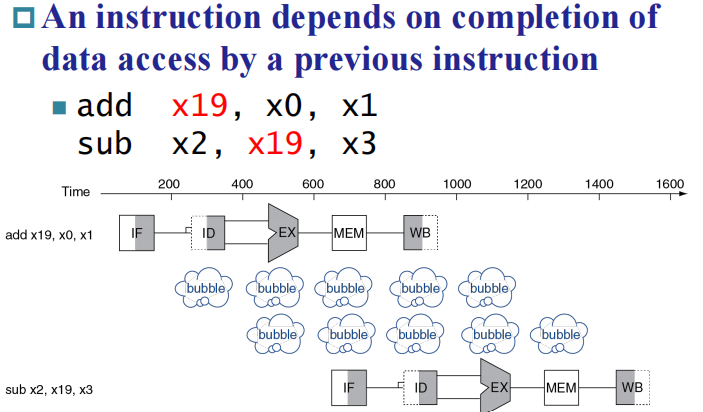
解决方案是在两条指令中插 bubble,这时 WB 和 ID 在同一个地方,我们只需在前半个时钟写入(时钟下降沿写),后半个时钟读即可。
Forwarding
但是这种情况经常发生,如果一直插 bubble 的话,流水线加速的意义就不是很明显了。 注意到上图中,add 的结果在 EX 步骤就得到了,实际上是不需要经过 MEM 的,这时我们采用 Forwarding 的方法,如下图所示:

但如果前面是个 load 指令,需要在 MEM 访问完之后才得到数据,因此必须插一个 bubble,如下图所示:

或者我们可以 reschedule code to avoid stalls:
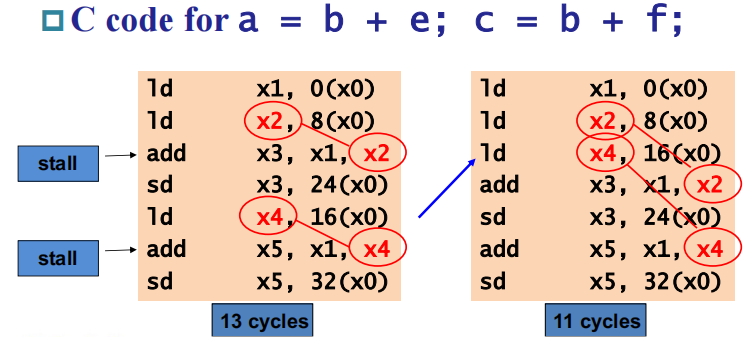
Control Hazards¶
- Branch determines flow of control
- Fetching next instruction depends on branch outcome
- Pipeline can't always fetch correct instruction(still working on ID stage of branch)
- In RISC-V pipeline
- Need to compare registers and compute target early in the pipeline
- Add hardware to do it in ID stage


Pipeline Summary
- Pipelining improves performance by increasing instruction throughput.
- Subject to hazards.
- Instruction set design affects complexity of pipeline implementation.
RISC-V Pipelined Datapath¶
Pipeline registers
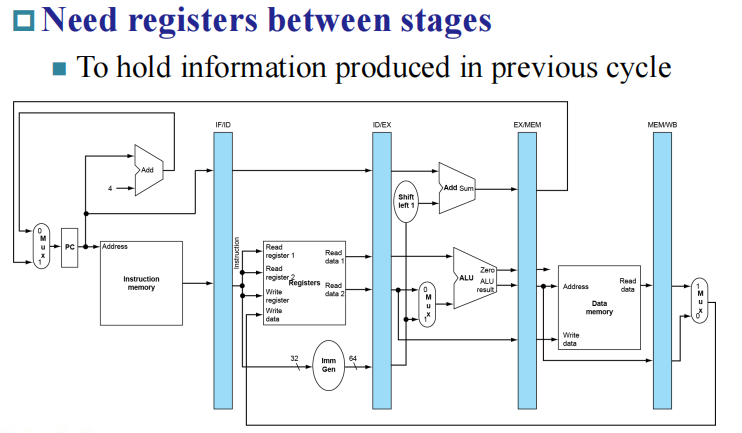
流水线填满的时候,每个 stage 执行的都是不同的指令,因此我们需要流水线寄存器存储指令。
Example
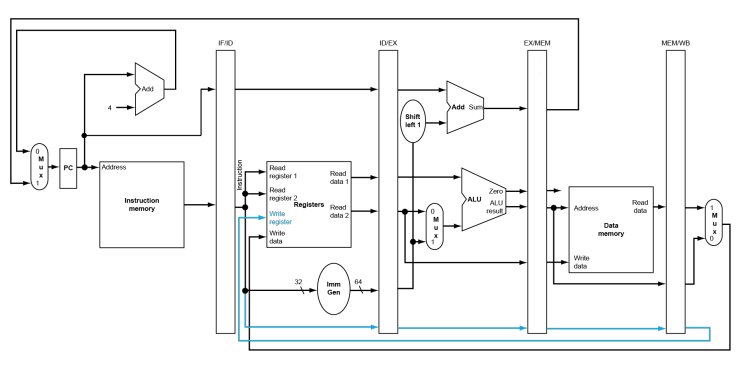
对于 load 指令的 WB 阶段,我们不能直接写回 register,因为此时的控制信号与写回地址是处在 IF/ID 寄存器中的指令。因此我们需要保存该指令的相关信号,如图中蓝线所示。
Multi-Cycle Pipeline Diagram
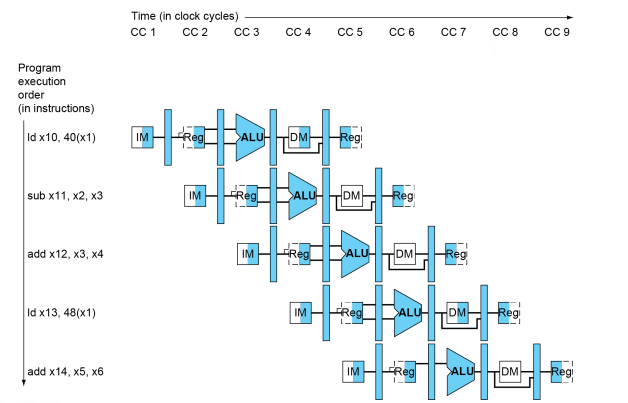
Single-Cycle Pipeline Diagram
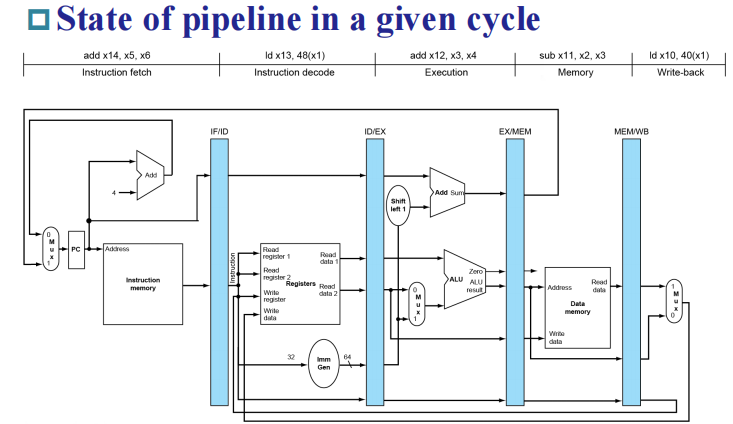
Pipelined Control¶
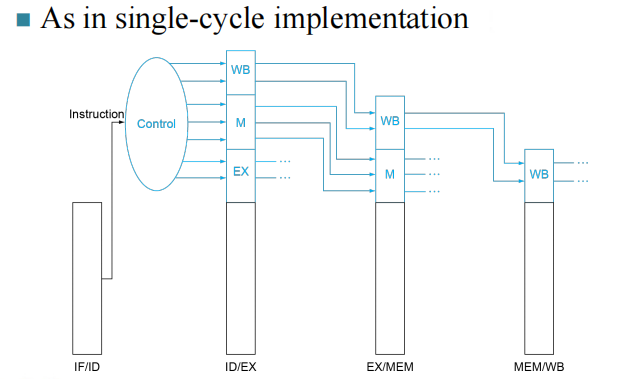
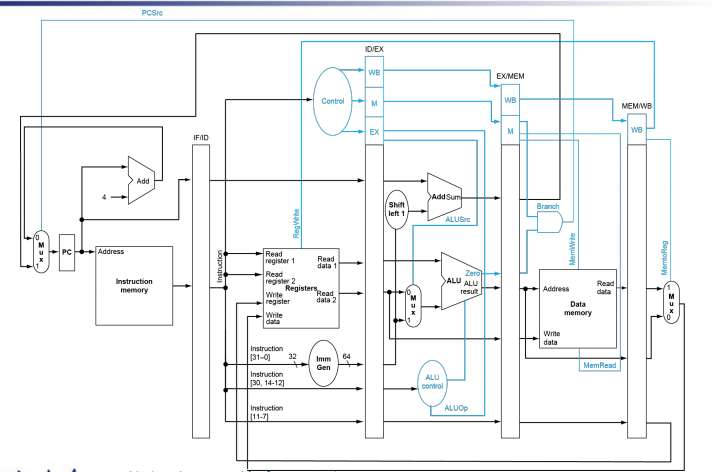
Data Hazards¶

首先需要注意的是,并不是只有相邻指令才需要 forwarding 的,需要画出 multi diagram 判断,如上图所示。
并且第一条指令与第二、三条是有数据竞争的,与后面两条指令并不冲突。
Detecting the Need to Forward¶
我们在每一级的寄存器中都会有编号:
ID/EX.RegisterRs1: register number for rs1 sitting in ID/EX pipeline register.
- ALU operand register numbers in EX stage are given by
ID/EX.RegisterRs1, ID/EX.RegisterRs2. - Data hazards when:
- EX/MEM.RegisterRd = ID/EX.RegisterRs1
- EX/MEM.RegisterRd = ID/EX.RegisterRs2
- MEM/WB.RegisterRd = ID/EX.RegisterRs1
- MEM/WB.RegisterRd = ID/EX.RegisterRs2
但是只有需要写回寄存器的指令需要 forwarding:
- EX/MEM.RegWrite, MEM/WB.RegWrite
- EX/MEM.RegisterRd 和 MEM/WB.RegisterRd 不是
x0。
Forwarding Paths

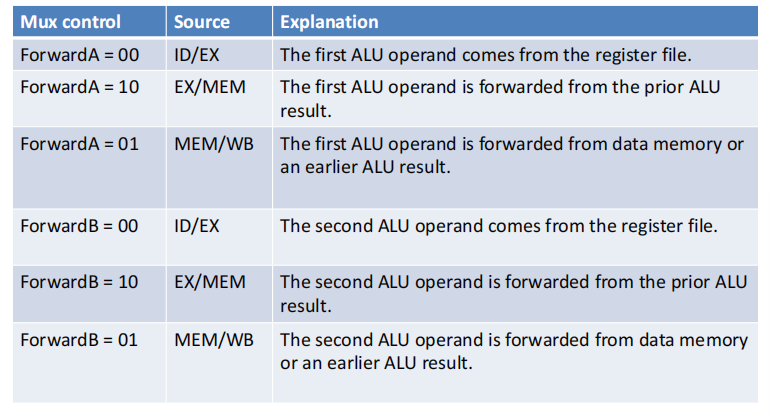
Double Data Hazard

Revised Forwarding Condition
不是很理解
Load-Use Hazard Detection¶
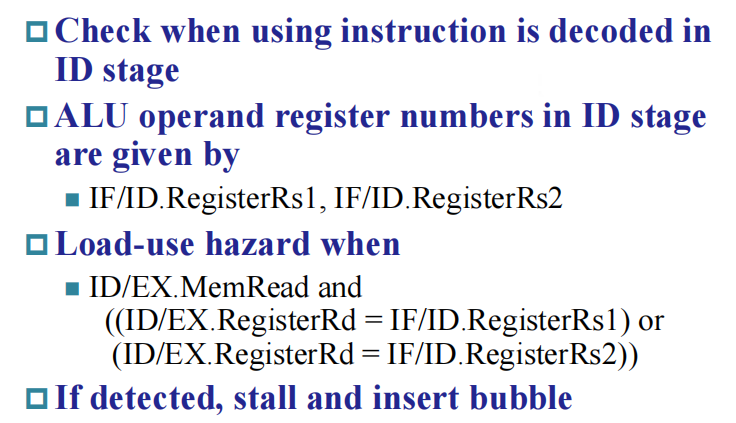
How to Stall the Pipeline

Stalls and Performance
- Stall reduce performance, but are required to get correct results.
- Compiler can arange code to avoid hazards and stalls.
Branch Hazards¶
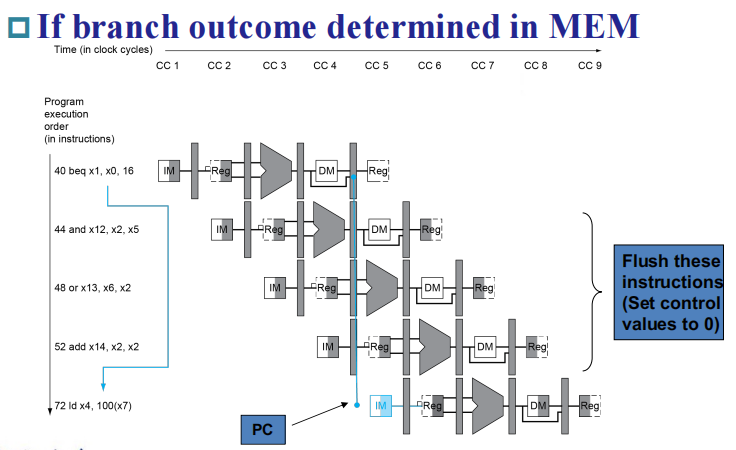
一个很直观的想法就是把中间三条指令 flush 掉,但是这样我们就要等比较长的时间,因此我们考虑 reducing branch delay:
Move hardware to determine outcome to ID stage
- Target address adder
- Register comparator
Branch Taken

在 ID 阶段判断是否跳转,如果跳转,则将当前处在 IF 阶段的指令 flush, 产生一个 bubble, bubble 过后直接执行跳转指令。
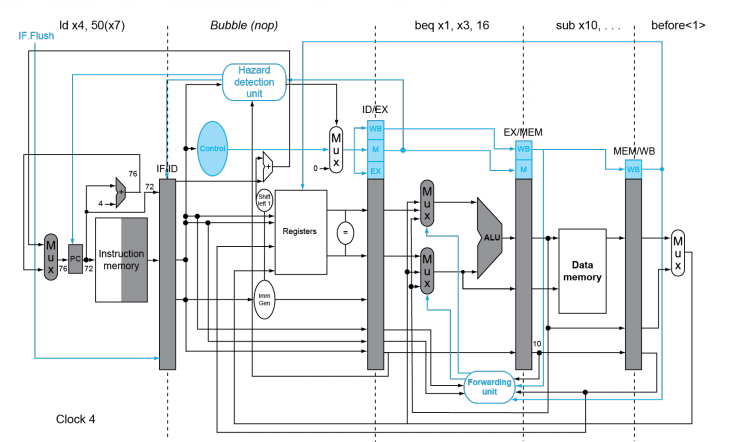
但是对于拆得更深的流水线(这里我们举的例子都是五级流水线,即将一条指令的 datapath 拆成五个阶段),使用上述的方法会增加代价。
Dynamic Branch Prediction
- Branch prediction buffer(branch history tabel)
- Indexed by recent branch instruction addresses
- Stores outcome(taken/not taken)
- To execute a branch
- Check table, expect the same outcome
- Start fetching from fall-through or target
- If wrong, flush pipeline and flip prediction
即建立一个索引表,存的是上次分支指令时是否命中,当前指令根据表中信息决定是否跳转,若不命中则更新表。
但是对于双层循环会存在问题:
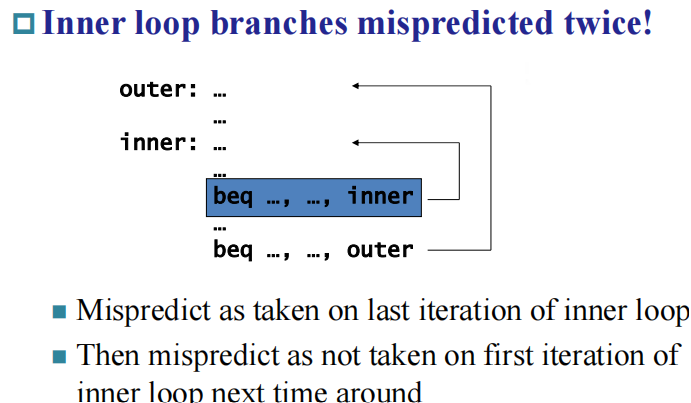
2-Bit Predictor
Only change prediction on two successive mispredictions
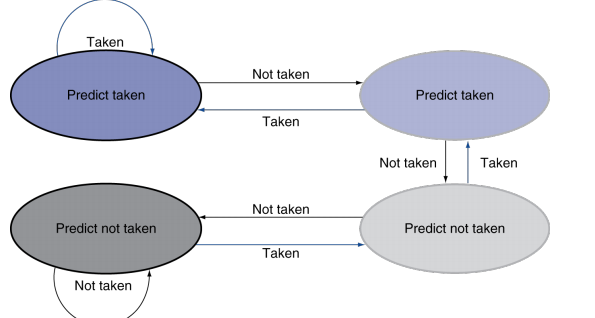
Even with predictor, still need to calculate the target address, resulting in 1-cycle penalty for a taken branch.
Branch targte buffer:
- Cache of target addresses
- Indexed by PC when instruction fetched
只存最新用的。
CPU within Exception¶
Exception(Interruption)¶
- The cause of changing CPU's work flow:
- Control instructions in program(bne/beq, j/jal, etc.), which is foreseeable in programming flow.
- Something happen suddenly(Exception and Inerruption), which is unpredictable
- Unexpected events:
- Exception: from within processor(overflow, undefined instruction, etc.)
- Interruption: from outside processor(input/output)
How Exceptions are handled?¶
- What must the processor do?
- When exception happens, the processor must do something.
- The predefined process routines are saved in memory when computer starts. (提前写好了程序)
- Problem:
- How can CPU go to relative routine when an exception occurs
- CPU should know: the cause of exception and which instruction generate the exception
RISC-V Privileged¶
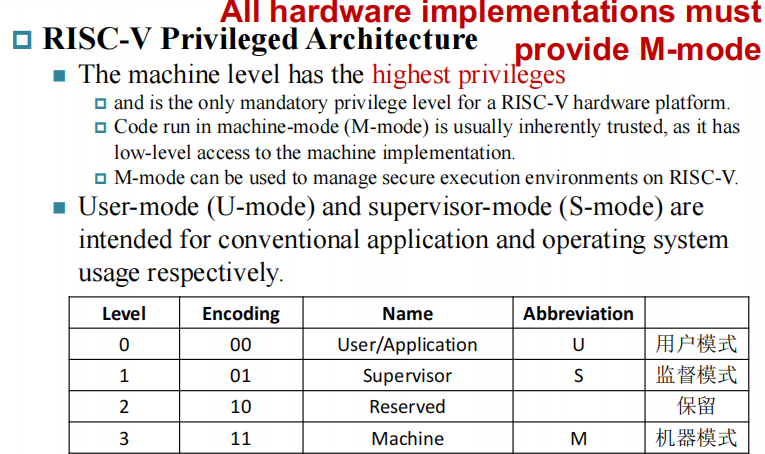
RISC-V interrupt structure¶
- 所有的硬件实现必须提供 M-mode
- as this is the only mode that has unfettered access to the whole machine.
- The simplest RISC-V implementations may provide only M-mode.
- Machine mode most important task
- to intercept and handle interrupts/exceptions
- There are 4096 Control and Status Registers(CSRs)
CSRs¶
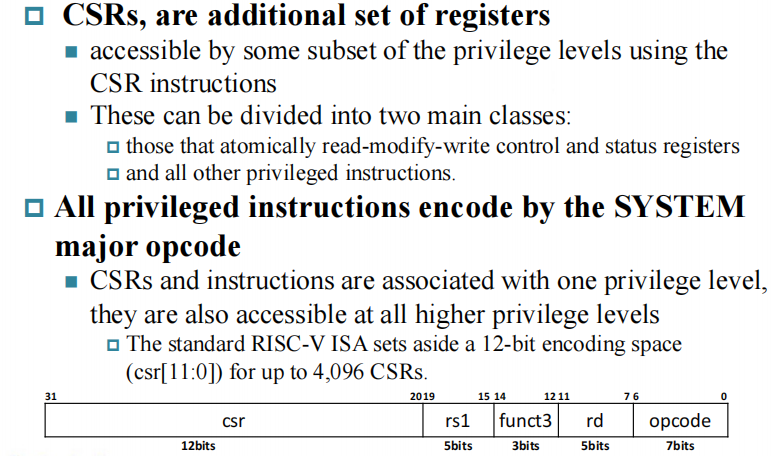
CSR 寄存器是专门用来处理中断/异常的寄存器,要用特权指令来访问。 这些指令可以分为两类:原子操作(read-modify-write, 一步完成)的指令和其它特权指令。
CSR Instruction
CSR 指令是专门用来更新 csr 寄存器的。

- CSRRW: 将 csr 的值读到 rd 寄存器,同时把 rs 的值更新到 csr 中。
- CSRRS: 将 csr 的值读到 rd 寄存器,同时 csr = csr | rs1 (set, 将对应的位变成 1 )。
- CSRRC: 将 csr 的值读到 rd 寄存器,同时 csr = csr ^ rs1 (clear)
Interrupts Instruction
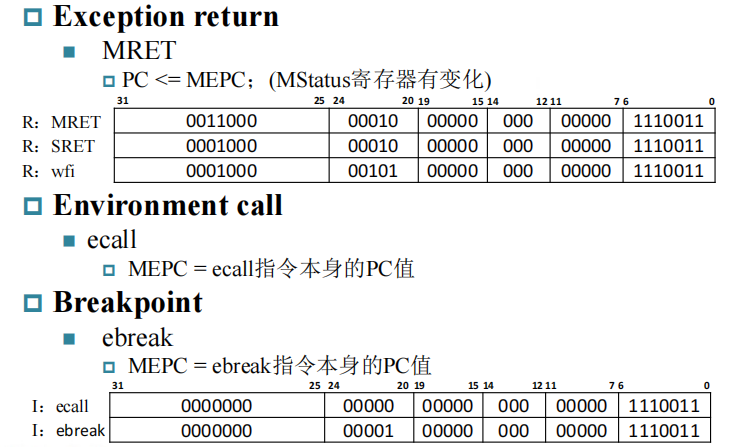
- MRET: 从什么模式进到机器模式,就回到什么模式。其中 MEPC 是跳转过去的指令地址。
- ecall:MEPC = ecall 指令本身的 PC 值。跳转到某个模式。
- ebreak: MEPC = ebreak 指令本身的 PC 值。
需要注意的是,我们一般是把下一条指令(PC+4)放到返回值的,但是这里我们将 ecall 本身的 PC 值赋给 MEPC。其实跳转过去的模式下的指令会将 MEPC 修改成希望返回的值。
Exception & Interrupt related registers

- mstatus
- Machine STATUS register
- Global interrupt enable bits:
MIE,SIE,UIE(provided for each priviledge mode) 不同模式下中断的管理情况(是否允许中断发生) xPIEholds ths value of the interrupt enable bit active prior to the trap. (进来之前的中断使能信号)xPPholds the previous privilege mode. (进来之前的模式)
- Global interrupt enable bits:
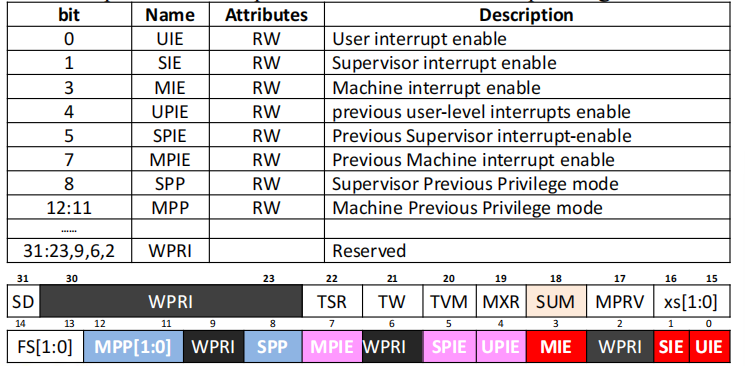
- mie/mip
更细的管理,局部使能。

- mtvec
产生中断后,CPU 需要知道去哪里执行中断程序。
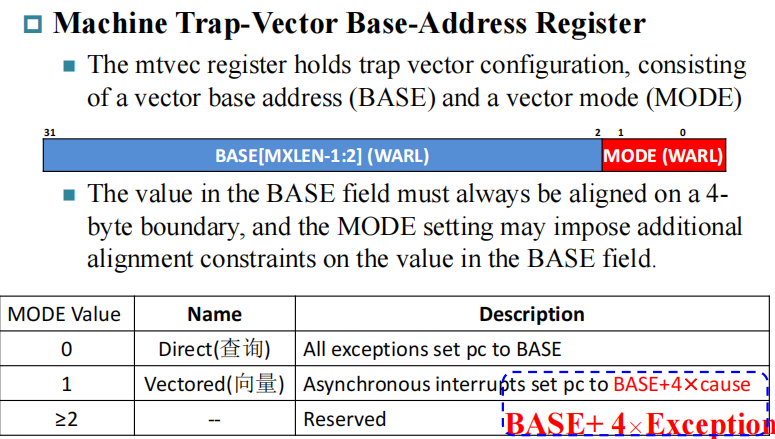
对于查询模式,PC 直接跳到 BASE, 然后根据 mcause 的值来执行对应的处理。
对于向量模式(只对中断有效),则直接跳转。
- mepc
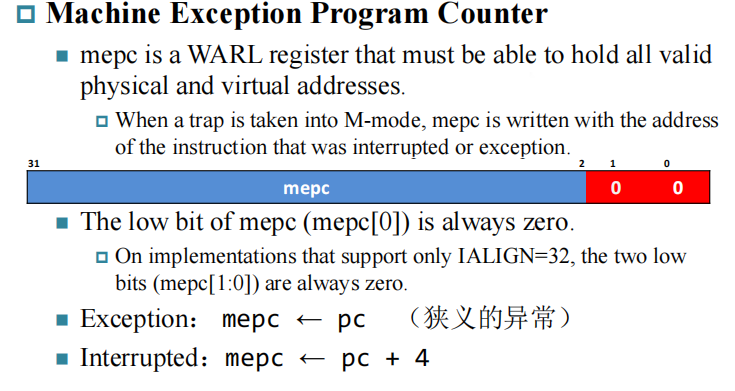
- mcause

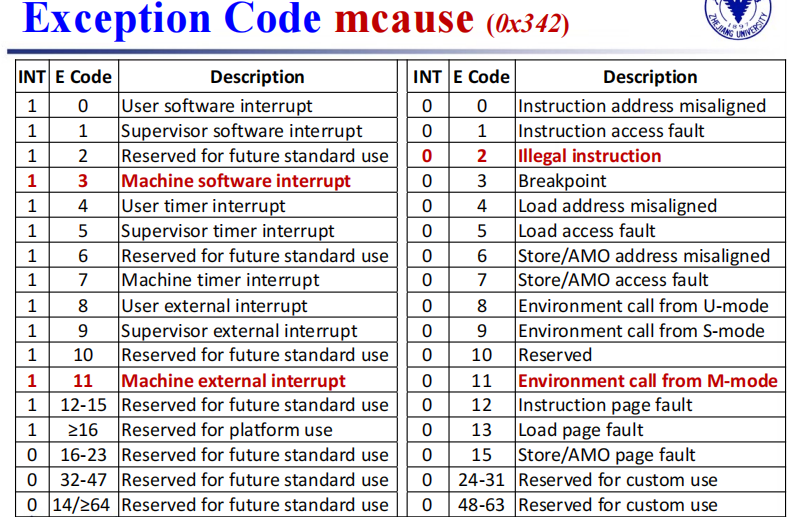
RISC-V Interrupt priority
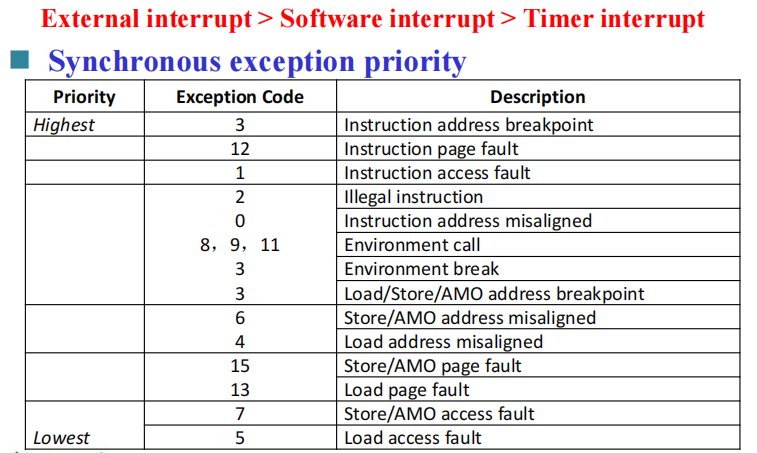
创建日期: 2024年4月16日 22:03:28